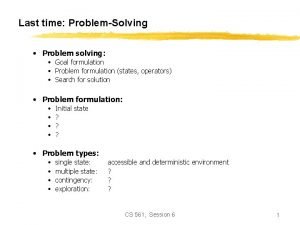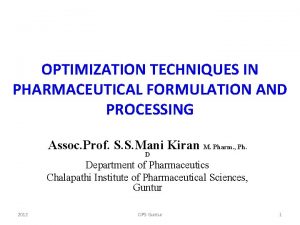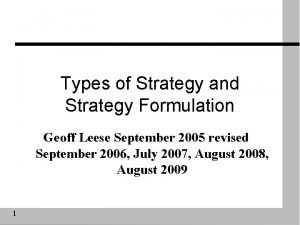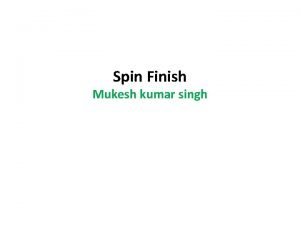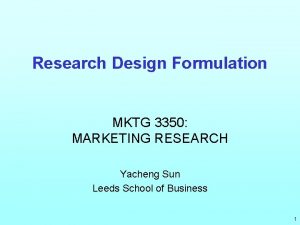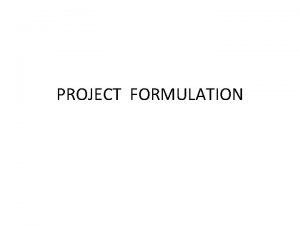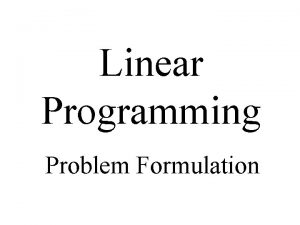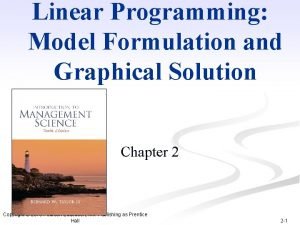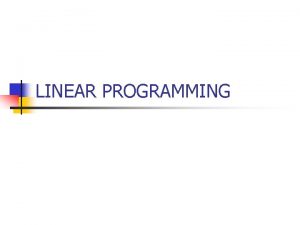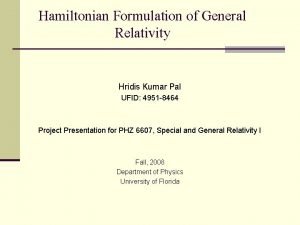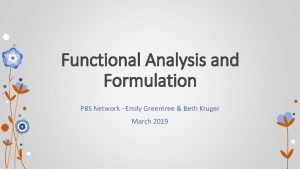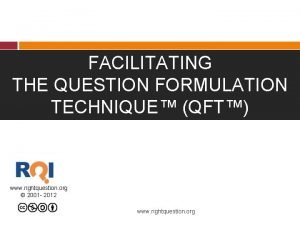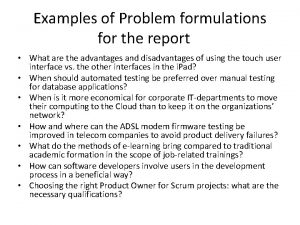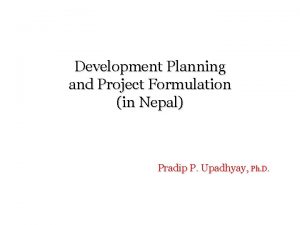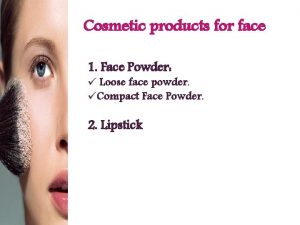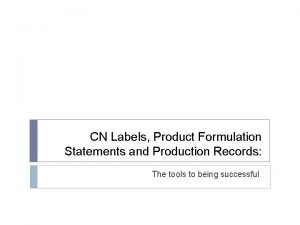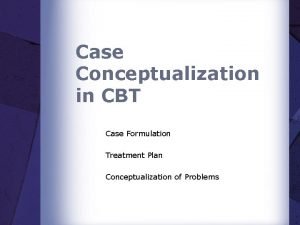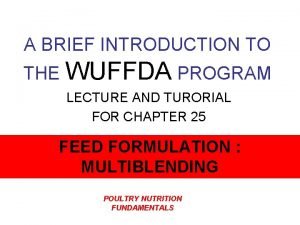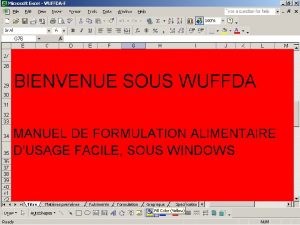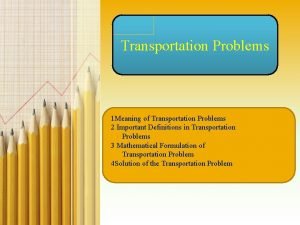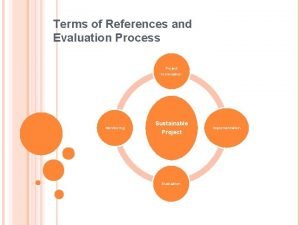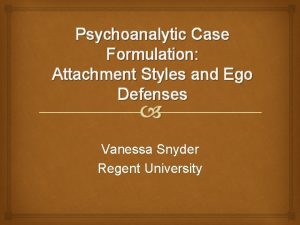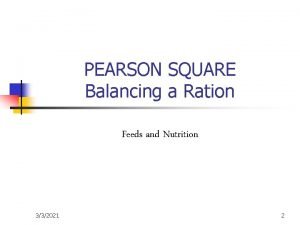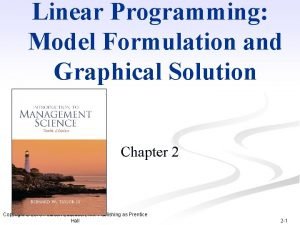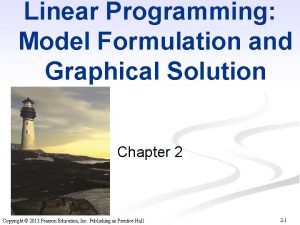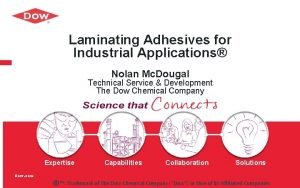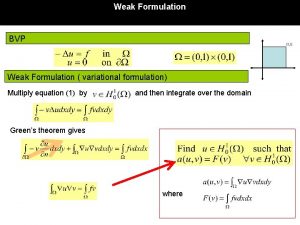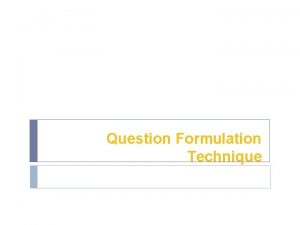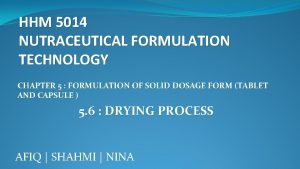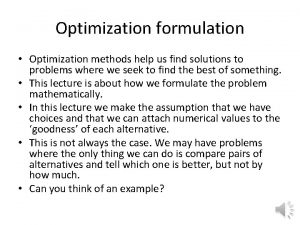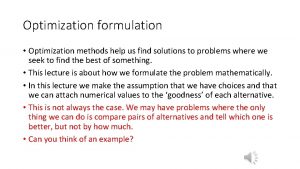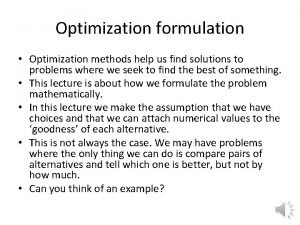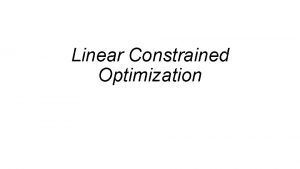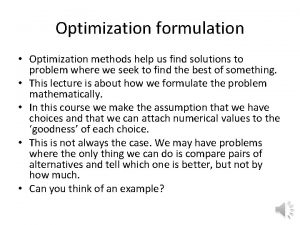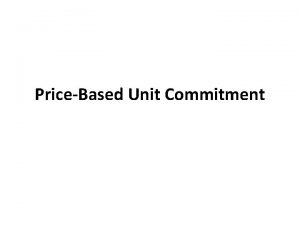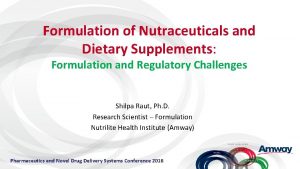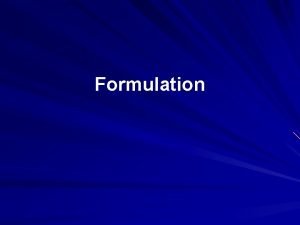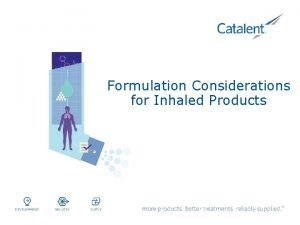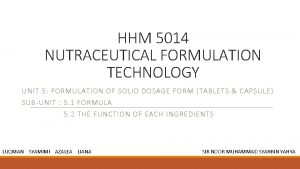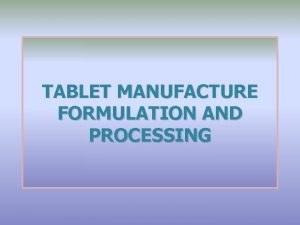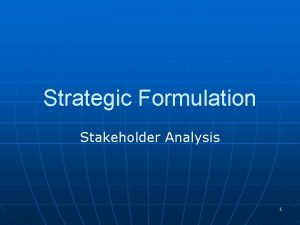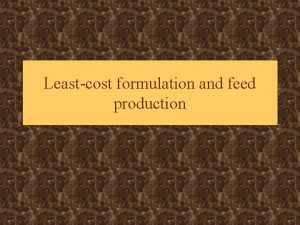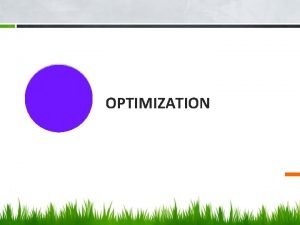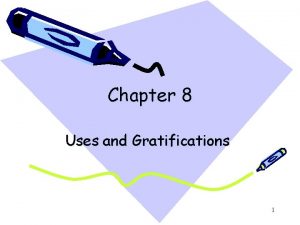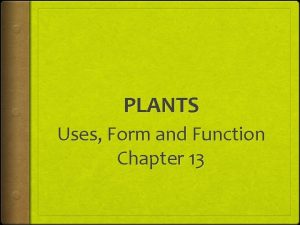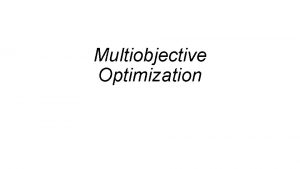Chapter 1 USES OF OPTIMIZATION FORMULATION OF OPTIMIZATION







































- Slides: 39

Chapter 1 • USES OF OPTIMIZATION • FORMULATION OF OPTIMIZATION PROBLEMS • OVERVIEW OF COURSE 1

Chapter 1 OPTIMIZATION OF CHEMICAL PROCESSES T. F. EDGAR, D. M. HIMMELBLAU, and L. S. LASDON UNIVERSITY OF TEXAS MCGRAW-HILL – 2001 (2 nd ed. ) PART I – PROBLEM FORMULATION II – OPTIMIZATION THEORY AND METHODS III – APPLICATIONS OF OPTIMIZATION APPENDICES (MATRIX OPERATIONS) 2

PHILOSOPHY OF BOOK Chapter 1 • Most undergraduates learn by seeing how a method is applied • Practicing professionals need to be able to recognize when optimization should be applied (Problem formulation) • Optimization algorithms for reasonably-sized problems are now fairly mature • Focus on a few good techniques rather than encyclopedic coverage of algorithms 3

Chapter 1 The Nature and Organization of Optimization Problems 4

WHY OPTIMIZE? 1. Improved yields, reduced pollutants Chapter 1 2. Reduced energy consumption 3. Higher processing rates 4. Reduced maintenance, fewer shutdowns 5. Better understanding of process (simulation) But there always positive and negative factors to be weighed 5

6 Chapter 1

7 Chapter 1

Chapter 1 OPTIMIZATION • Interdisciplinary Field Max Profit Min Cost Max Efficiency • Requires 1. Critical analysis of process 2. Definition of performance objective 3. Prior experience (engr. judgment) 8

9 Chapter 1

10 Chapter 1

11 Chapter 1

Chapter 1 Min reflux to achieve separation Figure E 1. 4 -3 Flooding constraint Optimal Reflux for Different Fuel Costs 12

13 Chapter 1

14 Chapter 1

15 Chapter 1

16 Chapter 1

Chapter 1 Material Balance Reconciliation 17

Chapter 1 Least squares solution: opt. m. A is the “average” value any constraints on m. A? 18

19 Chapter 1

Chapter 1 THREE INGREDIENTS IN OPTIMIZATION PROBLEM 20

21 Chapter 1

TABLE 1 Chapter 1 THE SIX STEPS USED TO SOLVE OPTIMIZATION PROBLEMS 1. Analyze the process itself so that the process variables and specific characteristics of interest are defined, i. e. , make a list of all of the variables. 2. Determine the criterion for optimization and specify the objective function in terms of the above variables together with coefficients. This step provides the performance model (sometimes called the economic model when appropriate). 22

Chapter 1 3. Develop via mathematical expressions a valid process or equipment model that relates the input-output variables of the process and associated coefficients. Include both equality and inequality constraints. Use well-known physical principles (mass balances, energy balances), empirical relations, implicit concepts, and external restrictions. Identify the independent and dependent variables (number of degrees of freedom). 23

Chapter 1 4. If the problem formulation is too large in scope: (A)Break it up into manageable parts and/or (B)Simplify the objective function 5. Apply a suitable optimization technique to the mathematical statement of the problem. 6. Check the answers and examine the sensitivity of the result to changes in the coefficients in the problem and the assumptions. 24

EXAMPLES – SIX STEPS OF OPTIMIZATION Chapter 1 specialty chemical 100, 000 bbl/yr. how many bbl produced per run? Step 1 define variables Q = total # bbl produced/yr (100, 000) D = # bbl produced per run n = # runs/yr 25

Step 2 develop objective function Chapter 1 inventory, storage cost = k 1 D production cost per run = k 2 (set up cost) + k 3 D operating cost per unit (could be nonlinear) 26

Step 3 Chapter 1 evaluate constraints D>0 Step 4 simplification – none necessary 27

Step 5 computation of the optimum Chapter 1 analytical vs. numerical solution 28

29 Chapter 1

Chapter 1 Step 6 Sensitivity of the optimum subst Dopt into C 30

31 Chapter 1

Chapter 1 RELATIVE SENSITIVITY (Percentage change) 32

Chapter 1 PIPELINE PROBLEM 33

Chapter 1 Equality Constraints 34

35 Chapter 1

min (Coper + Cinv. ) Chapter 1 subject to equality constraints need analytical formula for f substituting for ∆p, 36

Chapter 1 (constraint eliminated by substitution) 37

optimum velocity Chapter 1 non-viscous liquids gases (effect of ρ) 3 to 6 ft/sec. 30 to 60 ft/sec. at higher pressure, need to use different constraint (isothermal) for large L, ln ( ) can be neglected exceptions: elevation changes, slurries (settling), extremely viscous oils (laminar flow, 38 f different)

Chapter 1 Heat Exchanger Variables (given flow rate of one 1. heat transfer area fluid, inlet 2. heat duty temperatures, one 3. flow rates (shell, tube) outlet temp. , phys. 4. no. passes (shell, tube) props. ) 5. baffle spacing 6. length 7. diam. of shell, tubes 8. approach temperature 9. fluid A (shell or tube, co-current or countercurrent) 10. tube pitch, no. tubes 11. velocity (shell, tube) 12. ∆p (shell, tube) 13. heat transfer coeffs (shell, tube) 14. exchanger type (fins? ) 15. material of construction 39
 Why problem formulation follow goal formulation
Why problem formulation follow goal formulation Optimization techniques in pharmaceutical formulation
Optimization techniques in pharmaceutical formulation Role of hrm in strategy formulation
Role of hrm in strategy formulation Types of strategy formulation
Types of strategy formulation Spin finish oil formulation
Spin finish oil formulation Research design formulation
Research design formulation Project significance
Project significance The steps involved in portfolio selection
The steps involved in portfolio selection Product formulation statement
Product formulation statement The monophasic liquid
The monophasic liquid Product formulation statement
Product formulation statement Fundamentals of logical computing formulation
Fundamentals of logical computing formulation An animal feed company must produce 200 kg of a mixture
An animal feed company must produce 200 kg of a mixture Linear programming model formulation and graphical solution
Linear programming model formulation and graphical solution Mathematical formulation of lpp
Mathematical formulation of lpp Question formulation technique pdf
Question formulation technique pdf Question formulation technique
Question formulation technique Defining a research problem
Defining a research problem Hamiltonian formulation of general relativity
Hamiltonian formulation of general relativity 5 ps formulation
5 ps formulation 5ps formulation
5ps formulation Question formulation technique worksheet
Question formulation technique worksheet Problem formulation example
Problem formulation example Process of plan formulation in nepal
Process of plan formulation in nepal Formulation of face powder
Formulation of face powder Product formulation statement example
Product formulation statement example Case conceptualization and treatment planning example
Case conceptualization and treatment planning example Wuffda
Wuffda Wuffda feed formulation
Wuffda feed formulation Transportation problem meaning
Transportation problem meaning Power threat meaning framework formulation template
Power threat meaning framework formulation template Project formulation
Project formulation Primitive coping mechanism
Primitive coping mechanism Ner ned
Ner ned Pearson square feed formulation
Pearson square feed formulation Rheogistics
Rheogistics What is program logic formulation
What is program logic formulation Lp model formulation
Lp model formulation Linear programming model formulation and graphical solution
Linear programming model formulation and graphical solution Dougal nolan
Dougal nolan
